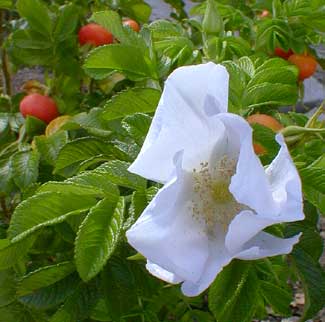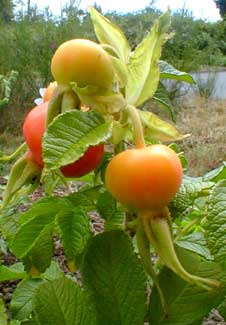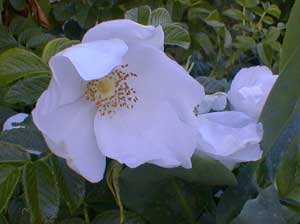
White Rugosa Rose
"As a brimming bowl, with crystal fill'd,
Came borne by the landlord's daughter,
Who wore in her bosom the fair white rose,
That grew best over the water."
-George Walter Thornbury
(1828-1876)
(1828-1876)
Rosa rugosa var alba or white rugosa rose is among the highest rated roses by the American Rose Society, & is a recipient of the Royal Horticultural Society's Award of Garden Merit. White Rugosa roses bloom primarily in the spring, especially in April & May, but also have sporadic moderate blooms until autumn. The first photo shows it in July; the third photo shows it in October. The blooms are singles about four inches wide.
This heirloom shrub has been gardened for centuries in Korea, China, & Japan, & in Europe since at least 1870. It is extremely cold-hardy & can suceed even in USDA zone 2, having a natural range in Asia as far north as eastern Siberia. In spite of being very sun-hardy for the xeriscape garden, it is not as heat-hardy as one might suppose, & is apt to fail above zone 8. Its ideal is temperate coastal maritime conditions, ultra-ideal for the coastal Northwest, or right here around Puget Sound.
Its large, edible, decorative hips are turning pink by July & are ripe & deep bright orange by August. Because the shrub reflowers over a long period, the hips are ripening serially early summer until mid-autumn. The ones which are harvested immediately after a good frost are sweetest, as the frost lowers the pectin & heightens the sugar content, but even the hips that ripen in summer are surprisingly sweet fresh from the bush. Though very seedy, the flavor is extremely appealing even raw, but they are usually cooked & strained for jellies due to the density of black seeds. If the cherry-tomato-sized hips are not harvested for jellies or other uses, they will remain on the branches after leaf-fall & continue to provide bright spots of color until autumn's end, occasionally into the start of winter.
 Because the hips are one of the most striking features ornamentally as well as a prized fruit for harvest, rugosas are not deadheaded, but maximum hip production is preferred. It will reflower even without deadheading, with hips & blossoms occuring side-by-side during summer, as can be seen on this page's uppermost photo in July.
Because the hips are one of the most striking features ornamentally as well as a prized fruit for harvest, rugosas are not deadheaded, but maximum hip production is preferred. It will reflower even without deadheading, with hips & blossoms occuring side-by-side during summer, as can be seen on this page's uppermost photo in July.As with a regular pink or red rugosa, white rugosa roses sucker & spread into thick six-foot-tall & wide groundcover. They can be restrained with regular removal of suckers, but left to their own devices can sometimes spread quite rapidly, forming impenetrable walls of stickery canes. Those grown in nearly boggy conditions may spread fastest; those in very dry gardens will be no less healthy & flowery, but will not sucker to quite such a distance quite so rapidly.
Because these shrubs are often started from seeds, even a single strain of "Alba" can have considerable variety from plant to plant. Some have bright orange hips, some scarlet. The best specimens have flowers to four inches wide, but some have smaller flowers. Some smell strongly of hyacinth; others have only a mild perfume. Ours is only mildly fragrant, but the spring flowers can be so numerous that they accumulatively perfume the air quite nicely.
Some specimens of 'Alba' seem to max out for height around four feet, others quite easily reach six or even seven feet of height. Some are nearly upright & form tall narrow shrubs, others grow as ramblers semi-prostrate & comparatively short. To me the ideal specimen is upright & narrow, as these look interesting even in winter when leafless; but there is something to be said for rugosas as "rambling roses" too, giving good ground coverage & perfect for preserving embankments against erosion. A specimen with especially nice traits will not be likely to produce identical specimens from seeds, but will do so from cuttings or by removing suckers to plant separately.
 Also because generally seed-grown, there can be color-variation for the appearance of "Alba." Many have bright yellow stamins, but some have fluffy creamy stamins. Some have rounder petals, some pointier. Some have a slight pinkish shading to their whiteness, though the ideal is a pure papery white.
Also because generally seed-grown, there can be color-variation for the appearance of "Alba." Many have bright yellow stamins, but some have fluffy creamy stamins. Some have rounder petals, some pointier. Some have a slight pinkish shading to their whiteness, though the ideal is a pure papery white.To call them thorny is an understatement. You can barely see the branches the thorns are so thick, making them ideal property edge hedge-plants guaranteed to put an end to trespassing.
When placing them in the garden, put them nowhere near a path or they will injure passersby. Plan for access for late winter prunings; if they are planted too close together you will be a bloody mess trying to care for them. While they don't require anything like the continuous attention of fancy hybrid roses that go all to hell if not tended almost weekly, for rugosas an annual pruning is even so a nightmare if you really thought you were going to be able to squeeze behind two of them in order to take out the spent canes in preparation for the new year's growth.
Autumn leaf color varies in excellence from specimen to specimen & year to year, but often the dark green leaves turn very pleasing shades of yellow & orange just before leaf-fall. The remaining canes have a striking wintry appeal all their own, more so if hips are unharvested.
Though it only needs to be hard-pruned once a year, ideally just before spring, it can be sheered at any time during the year if one wishes to keep them to four or five feet height, or force a more formal shape onto them. Such periodic sheering is not necessary, but the shrubs will respond nicely if a gardener is going for another effect.
A topdressing of composted manure can be placed around the shrub every winter or spring. It will not demand other fertilizer, though a little slow release doesn't harm it.
Quite the opposite of hybrid roses, rugosas are very nearly immune to diseases, fungal or otherwise. Apart from the essential pruning, they demand no attention to thrive, & never need the hideous chemical dousings which fancy hybrids seem all too often to demand. They will certainly not frustrate the radically organic gardener the way hybrid roses can; indeed, the type of gardener who relies on chemicals for everything would end up harming their rugosas, while the neighbor who ignores hers even in poor dry soil will have delightfully productive & healthful shrubs.
Too many fancy roses are hacked to homely bits, so that all energy goes into blooming & none into a grand appearance for the shrub overall. Rugosas frankly look better as bushes, in or out of bloom, than do fancy hybrids which have nice flowers only.
See also:
Rosa rugosa wild sea tomato
& see:
Rosa rugosa "Magnifica"
Rosa rugosa wild sea tomato
& see:
Rosa rugosa "Magnifica"